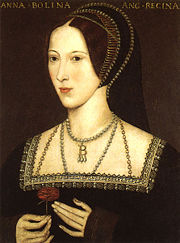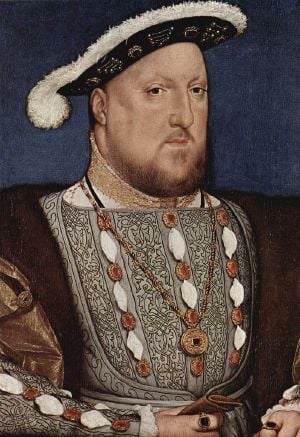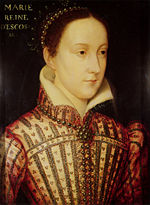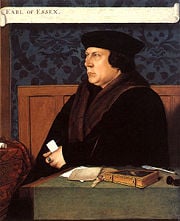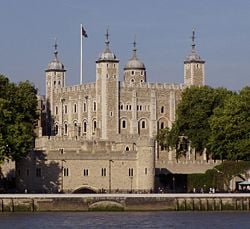Anne Boleyn
| Anne Boleyn | ||
|---|---|---|
| Queen Consort of England | ||
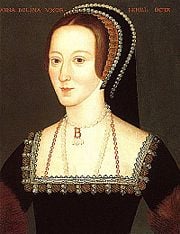
| ||
| Anne Boleyn | ||
| Born | ca. 1501/1507 (see The birth controversy) | |
| Died | May 19, 1536 | |
| Tower of London | ||
| Consort | June 1533 - May 19, 1536 | |
| Consort to | Henry VIII | |
| Issue | Elizabeth I | |
| Father | Thomas Boleyn, 1st Earl of Wiltshire | |
| Mother | Elizabeth Boleyn, Countess of Wiltshire | |
Anne Boleyn, 1st Marchioness of Pembroke (ca. 1501/1507 – May 19, 1536)[1] was the second wife of King Henry VIII and the mother of Queen Elizabeth I.
King Henry's marriage to Anne and her subsequent execution were part of the complex beginnings of the English Reformation, with Anne herself actively promoting the cause of Church reform. She wielded immense political influence and has been called "the most influential and important queen consort England has ever had."
Anne is most famously remembered because she was beheaded on charges of adultery, incest, and treason on May 19, 1536. Despite this, belief in her innocence was widespread and she was later celebrated as a martyr in English Protestant culture, particularly through the works of John Foxe. Her life has been adapted for numerous novels, plays, operas, television dramas, and motion pictures, including Anne of the Thousand Days, The Other Boleyn Girl and The Six Wives of Henry VIII.
Early Life
Due to a lack of parish records from the period, historians do not agree when Anne Boleyn was born. The academic debate centers around two key dates: 1501 and 1507.
Anne was the daughter of Sir Thomas Boleyn and his wife, Lady Elizabeth Boleyn (born Lady Elizabeth Howard), who was the daughter of the 2nd Duke of Norfolk. She was born either at her family's mansion, Blickling Hall in Norfolk, or at their favorite home, Hever Castle in Kent. It was later rumored that Anne was born with six fingers on her left hand, a supposed sign of he relationship with the Devil. However is no contemporary evidence to support this.[2][3]
Anne had two siblings, and older sister, Mary, and a brother, George. George was born sometime around 1504, making him older if Anne was born in 1501, but younger if she was born in 1507.
At the time of Anne’s birth, the Boleyn family was one of the more respectable families in the English aristocracy, although they had only held a title for four generations. The report of the Boleyns as social-climbing minor nobility seems to be exaggerated. In the words of one of her biographers, "Tradition also tells us that the Boleyns were a family of London merchants, and again tradition leads us astray. Anne Boleyn was born a great lady [of the aristocracy]."[4] Her great-grandparents included a Lord Mayor of London, a duke, an earl, two aristocratic ladies and a knight. She was certainly more aristocratic than either Jane Seymour or Catherine Parr, two of Henry's other English wives.
Anne's father was a respected diplomat with a gift for languages. He was also a favorite of Henry VII and was sent on many diplomatic missions abroad. Thomas Boleyn's professionalism and charm won many admirers, including Archduchess Margaret of Austria, the daughter of Maximilian I, the Holy Roman Emperor. She ruled The Netherlands on behalf of her father and was so impressed with Boleyn that she offered Anne a place in her household. Anne made a good impression in The Netherlands with her manners and studiousness and lived there from the spring of 1513 until her father arranged for her to continue her education in Paris in the winter of 1514.
In France, Anne was a favored lady-in-waiting to Queen Claude of France and also acted as an interpreter whenever high-ranking English visitors came to the French court. In the queen's household, she completed her study of French and acquired a thorough knowledge of French culture and etiquette. She also developed an interest in fashion and religious philosophy that called for reform of the Church. Her European education ended in the winter of 1521 when she was summoned back to England on her father's orders, in January 1522.
Appearance and personality
Anne Boleyn was not conventionally beautiful for her time. People seemed primarily attracted by Anne's charisma. She was thin and had dark eyes and long, dark hair. She possessed an impressive fashion sense, inspiring many new trends among the English court ladies. According to one account:
“Anne’s charm lay not so much in her physical appearance as in her vivacious personality, her gracefulness, her quick wit and other accomplishments. She was petite in stature, and had an appealing fragility about her… she shone at singing, making music, dancing and conversation… Not surprisingly, the young men of the court swarmed around her.”[5]
Anne was a devout Christian in the new tradition of Renaissance Humanism[6] Calling her a Protestant would be an overstatement. She also gave generously to charity and sewed shirts for the poor. In her youth she was "sweet and cheerful" and enjoyed gambling, drinking wine, and gossiping. She was also courageous and passionate. According to her critics, Anne could also be extravagant, vindictive, and bad-tempered.
Relations with Henry VIII
A royal love affair
Immediately on her return to England, Anne became a lady-in-waiting to Queen Catherine of Aragon, Henry VIII's Spanish wife. Catherine was popular with many people, although she had been inactive in politics and court life for some time. All of her sons by Henry had died young and Henry was anxious for a male heir to his throne in order to preserve the monarchy and prevent civil war.
Anne Boleyn made her court début at a masquerade ball in March 1522, where she performed an elaborate dance accompanying the king's younger sister, several other great ladies of the court, and his mistress—Anne’s sister, Mary. Within a few weeks of this performance, Anne was known as the most fashionable and accomplished woman at the court.
During this time, she was being courted by Henry Percy the son of the Earl of Northumberland. The romance was broken off in 1523 when Lord Henry's father refused to support their engagement. Anne was briefly sent from court to her family’s countryside estates, but it is not known for how long. When she returned to court she gathered a group of male admirers around herself, but became well known for her ability to keep men at arm's length. The British ambassador and poet Sir Thomas Wyatt, wrote about her in the sonnet, in which he described her as unobtainable and headstrong, despite seeming demure and quiet.[7] It was in 1525 that Henry VIII became enamored with her and began his pursuit.
Anne rejected the king’s initial advances by saying, “I beseech your highness most earnestly to desist, and to this my answer in good part. I would rather lose my life than my honesty.”[8] The king, however, became even more attracted to her because of this refusal, and he pursued her relentlessly, even after she left the court to return to Kent. Historians are divided over Anne’s motivations in rejecting Henry. Some say it was virtue, and others say it was shrewd ambition, seeking to become his queen rather than his mistress. Eventually, he proposed and she accepted. However, she reportedly decided not to sleep with Henry before their marriage, as pre-marital intercourse would mean that any children they had would be born out of legitimate wedlock. Henry and his ministers applied to the Vatican in 1527 for an annulment of his marriage to Catherine.
In the initial stages of their relationship, Anne was kept in the background, but by 1528 it was common knowledge that Henry intended to marry her. Anne’s relatives promoted her cause, and they had many supporters at court. Initially, she kept herself out of politics. She reveled in her newfound lifestyle. Henry paid for her expenses, and she accumulated a large wardrobe of gowns, furs and jewels. She was given her own staff of servants, several ladies-in-waiting, and new palace apartments.
The power behind the throne
In 1529, Pope Clement VII was no nearer to granting Henry an annulment than he had been in 1527. The Boleyns' spies reported that part of the problem was that the Emperor Charles V, Catherine of Aragon’s nephew, had taken Clement captive. As political tension mounted overseas, the English court was thrown into turmoil back home. The support of Thomas Cardinal Wolsey, the king's Chancellor, was called into question.
Convinced that Wolsey was treacherous, Boleyn maintained pressure until Wolsey was dismissed from public office in 1529. The cardinal begged Anne to help him return to power, but she refused. He then began a plot to have Anne forced into exile and began communication with Queen Catherine and the pope to that end. When this was discovered, Henry ordered Wolsey's arrest, and had it not been for his death from natural causes in 1530, he might have been executed for treason. A year later, Queen Catherine was banished from court and her old rooms were given to Anne. With Wolsey gone, Anne Boleyn became the most powerful person at court. She had considerable power over government appointments and political matters. Her exasperation with the Vatican’s refusal to make her queen also persuaded her to promote a new course to Henry. She suggested that he should follow the advice of religious radicals like William Tyndale, who denied papal authority and believed that the monarch should lead the church. When the conservative Archbishop of Canterbury William Warham died, Boleyn succeeded in having her family's chaplain, Thomas Cranmer, appointed to the position. She also supported the rise of the reformer Thomas Cromwell, who became the king's favorite new adviser.
During this period, Anne Boleyn also played a significant role in England's international position by solidifying an alliance with France. She established an excellent rapport with the French ambassador, Giles de la Pommeraye, who was captivated by her. With his help, she arranged an international conference at Calais in the winter of 1532, in which Henry hoped he could enlist the support of Francis I of France for his new marriage.
Before going to Calais, Henry bestowed upon Anne the Marquessate of Pembroke, making her the first English female to achieve a noble title in her own right by creation, rather than through inheritance. Anne’s family also profited from the relationship; her father, already Viscount Rochford, was created Earl of Wiltshire and Earl of Ormonde in Ireland. Thanks to Anne’s intervention, her widowed sister Mary received an annual pension of £100, and Mary's son, Henry Carey, received his education in a prestigious Cistercian monastery.
Marriage
| The Six Wives of King Henry VIII |
|---|
The conference at Calais was a political triumph, since the French government finally gave its support for Henry's remarriage. Immediately upon returning to Dover in England, Henry and Anne were secretly married, finally enjoying a sexual relationship after seven years.[9] She became pregnant within a few months and, as was the custom with royalty, there was a second wedding service, which took place in London on January 25, 1533.
Catherine was formally stripped of her title as queen in time for Anne's coronation in June 1533. In defiance of the pope, Archbishop Cranmer now declared that the English Church was under Henry’s control, not Rome's. Queen Anne was delighted at this development. Although she remained a Catholic, she believed, as did many Christian humanists of the day, that the papacy was a corrupting influence on Christianity. Her residual Catholic tendencies can be seen in the ostentatious devotion to the Virgin Mary throughout her Coronation displays.[10]
After her coronation, she settled into a quiet routine to prepare for the birth of her child. She became deeply distressed, however, when Henry was infatuated with a lady of the court, which provoked their first serious fight. The affair was brief, since Henry wanted nothing to jeopardize his wife's pregnancy.
Henry and Anne's child was born slightly prematurely on September 7, 1533, at the king's favorite palace, Greenwich Palace. The child was a girl who was christened Elizabeth, in honor of Henry's mother, Elizabeth of York. She was given a splendid christening, but Boleyn feared that Catherine's daughter, Mary, would threaten Elizabeth’s position. Henry soothed his wife's fears by separating Mary from her own servants and sending her to Hatfield House, where Princess Elizabeth was living with her own magnificent staff. Boleyn was reportedly an affectionate mother who regularly visited her daughter.[11] Her visits were also scenes of friction between her and Princess Mary, who referred to her as "my father’s mistress," while Anne called Mary "that cursed bastard."
Life as queen
Boleyn had a larger staff than Catherine, with 250 servants over 60 maids-of-honor, whose parents hoped the queen would arrange a suitable marriage for their daughters. She maintained strict control over her maids’ morals and spiritual well-being. She also employed several priests who acted as her confessors, chaplains, and religious advisers. Her favorite was the religious moderate, Matthew Parker, who would become one of the chief architects of the modern Church of England under her daughter Elizabeth I.[12]
Anne's reputation as a religious reformer spread through Europe, and she was hailed as a heroine by Protestant figures. Even Martin Luther viewed her rise to the throne as a good sign. She also saved the life of the French radical Nicolas Bourbon, who was sentenced to death by the French Inquisition, by appealing to the French royal family. Bourbon would later refer to her as "the queen whom God loves." Anne also championed the translation of the Bible into English. She gave generously to charities, distributing alms for the relief of the poor and funds to educational foundations. Anne was also important as a patron of the arts, particularly in relation to Hans Holbein.
Meanwhile, a group of young gentlemen continued to visit the queen’s quarters, where they flirted with her ladies-in-waiting and even danced with the queen. She reportedly never stepped beyond propriety, even going so far as to reprimand them if they became too jovial with her or her maids. There was nothing new in this, for a group of young men had also served as Catherine of Aragon’s adherents in the 1510s. It was only later that this behavior would harm Anne’s reputation.[13]
Boleyn's married life was stormy. The royal couple enjoyed periods of calm and affection, but Henry's frequent infidelities greatly upset his new wife, who reacted with tears and rage to each new mistress. For his part, Henry found Boleyn’s strident opinions about religion and politics irritating. Her second pregnancy resulted in a miscarriage in the summer of 1534. Henry saw her failure to give him a son as a betrayal.
The French ambassador reported on the frosty atmosphere between the royal couple at a banquet in 1535. When he asked Boleyn about it later in the evening, she told him that she felt utterly lonely and that she could feel the eyes of the entire court spying on her. This pressure inflamed her temper, and she clashed with her uncle, Thomas Howard, 3rd Duke of Norfolk, when she discovered that his loyalty to her was suspect. When her sister Mary secretly married a commoner, she exiled her from court. Both sisters refused to apologize to one another, and Mary wrote a letter proclaiming her steadfast love for her new husband. Anne later relented by sending the newlyweds a magnificent wedding present, but she still refused to receive them back to court.
Death of Catherine of Aragon
In January 1536, Catherine of Aragon died of cancer. Upon hearing the news of her death, Henry and Anne reportedly decked themselves in bright yellow clothing. While some have interpreted this as a public display of joy regarding Catherine's death, historians point out that yellow was Spain's national color of mourning during the era, and was worn out of respect for the deceased.
Rumors circulated that Catherine had been poisoned, due to the fact that during her embalming, he heart was found to be blackened. Modern medical experts are in agreement that cancer of the heart would have caused this condition, but this was not understood at the time.[14] In the aftermath of Catherine’s death, Anne attempted to repair relations with Catherine's daughter, Mary, but she was rebuffed.
Downfall
On the day of Catherine’s funeral, January 29, 1536, Boleyn miscarried again, and the fetus was revealed to be a male. Most observers see this loss as the beginning of the end of the royal marriage.
As Anne recovered from her miscarriage, Henry declared his marriage was cursed by God. Jane Seymour was moved into new quarters and Anne's brother was refused a prestigious court honor, the Order of the Garter, which was instead given to Jane Seymour's brother. On several occasions throughout these months, Anne expressed the fear that she was about to be divorced.
In the last few days of April, a Flemish musician in Anne's service named Mark Smeaton was arrested and tortured by Thomas Cromwell on suspicion of adultery with the queen. He initially denied that he was the queen’s lover, but under torture he confessed. He also provided the names of another courtier—Sir Henry Norreys (or Norris)—an old friend of both Anne and the King. Norris was arrested on May Day, but since he was an aristocrat he could not be tortured. He denied his guilt and swore that Boleyn was also innocent. Sir Francis Weston was arrested two days later on the same charge. William Brereton, a groom of the king's privy chamber, was also apprehended on grounds of adultery, but it seems likely he was really the victim of an old grudge against him, held by Thomas Cromwell. The final accused was Queen Anne's own brother, arrested on charges of incest and treason with her.
On May 2, 1536, Anne herself was arrested at her luncheon and taken to the Tower of London. In the Tower, she reportedly suffered a minor nervous breakdown.
Four of the accused men were tried in Westminster on May 15, 1536. Weston, Brereton and Norris publicly maintained their innocence and only the tortured Smeaton supported the Crown by pleading guilty. Two days later, Anne and George Boleyn were tried separately in the Tower of London. She was accused of adultery, incest, witchcraft, and high treason. Popular suspicion against Henry and his mistress, Jane Seymour, both of whom were seen banqueting on the Thames, was widespread. Several pamphlets circulated in London mocking the trials and supporting the queen.
Just before Anne's execution on charges of adultery, her marriage to the King was dissolved and declared invalid. The question was overlooked, as to how she could have committed adultery if they had never been married.
Execution
George Boleyn and the other accused men were executed on May 17. Lord and Lady Kingston, the keepers of the Tower, reported that Anne actually seemed happy, composed, and ready to be done with life. Lord Kingston brought her the news that the King had changed her sentence from burning to the less painful and more noble beheading, and that Henry had employed a famous swordsman from Calais for the execution, rather than having the queen beheaded with the common axe. She replied: "He shall not have much trouble, for I have a little neck."
On the morning of May 19 Anne was escorted to the Tower Green, where she was to be afforded the dignity of a private execution. She wore a plain, dark gown with a mantle of ermine. Her dark hair was bound up and she wore a headdress. The sources do not agree as to what else she wore beyond these specific points. She made a short speech:
"…I am come hither to accuse no man, nor to speak anything of that, whereof I am accused and condemned to die, but I pray God save the king and send him long to reign over you, for a gentler nor a more merciful prince was there never. And to me he was ever a good, a gentle, and sovereign lord. And if any person will meddle of my cause, I require them to judge the best. And thus I take my leave of the world and of you all, and I heartily desire you all to pray for me. O Lord have mercy on me, to God I commend my soul." (original letter printed by Sir Henry Ellis, as written at the moment by Kingston, lieutenant of the Tower, Bayston, [15]
She then knelt upright, as in French-style executions, which used a sword rather than an axe, there was no block. Her final prayer consisted of her repeating, "To Jesus Christ I commend my soul; Lord Jesus receive my soul." Her ladies removed the headdress and tied a blindfold over her eyes. The execution was swift, comprising of a single stroke. According to one tale, the swordsman was so taken with Anne that he said, "Where is my sword?" to distract her into thinking that she had just a few moments longer to live and would not know that the sword was coming.
The government did not provide a noble coffin for Anne. Her body and head were put into an arrow chest and buried in an unmarked grave in the Chapel of St. Peter ad Vincula. Her body was identified in renovations of the chapel during the reign of Queen Victoria, and Anne's final resting place is now marked in the marble floor.
Historiography
Historians still debate why Anne's fall from the throne took place. There are four main theories about Anne Boleyn's demise, which the Oxford historian Steven J. Gunn described as historical "trench warfare."
- Guilty of adultery: The English historian George W. Bernard argues that Anne was guilty of adultery and treason. In 1991 he wrote, "Perhaps the safest guess for a modern historian is that Anne had indeed committed adultery with Norris and briefly with Mark Smeaton and that there was enough circumstantial evidence to cast reasonable doubt on the denials of the others." The witchcraft and related charges, of course, he rules out.
- A romantic victim: The traditional theory is that Anne was the victim of her husband's cruelty and that her failure to produce a son meant that Henry would stop at nothing to get rid of her. Tudor historian Sir Geoffrey Elton stated that "Anne and five men were put to death by due process of law because the king wished to marry again…. Henry had now so far discarded scruple that to get his way he was prepared to appear as a cuckold and a victim of witchcraft".[16]
- A political attack: Another popular theory is that Anne was removed by a palace plot orchestrated by Thomas Cromwell for political reasons. An alliance with Spain had become desirable, and Anne was so unpopular with the Spanish royal family that her presence was a serious obstacle to progress.
- Sexual heresy: The American academic Retha Warnicke argued that the alleged deformity of the fetus Anne miscarried in January 1536 led to the belief that the queen might have links to perverse sexual practices and the occult. Her so-called lovers were, probably homosexual and were thus equally likely to be victimized by sixteenth century sexual prejudices.
A combination of these theories also possible, and except for the first case, seems to be a likely explanation.
Legacy
Anne's most important legacy was left through her daughter, Elizabeth I, who became one of England's most effective and long-lived monarchs. It is ironic that Henry's need for a male heir played such a significant part in Anne's demise, for Elizabeth proved to be greater than any Tudor king with the possible exception of Henry himself.
For 20 years after her death, Anne was seldom discussed, although in ultra-Catholic circles several dark legends were deliberately nurtured—particularly the stories of her deformity which and her links to the Devil through witchcraft. An exiled Jesuit priest, Nicholas Sander, published various allegations in 1576, including that Anne Boleyn had actually been her husband's biological daughter, and had been sexually active from childhood with the brother and others. Catholic historians of the Reformation later moderated these allegations into the charge that Anne had simply been a promiscuous and immoral woman, but stopped suggesting that she had been a witch. The extreme criticism of Anne and her sister Mary formed the imaginative basis of the bestselling British novel, The Other Boleyn Girl.
After 1558, Anne was venerated as a martyr and heroine by English Protestantism, particularly through the works of the ultra-Protestant propagandist, John Foxe, who argued that Anne had saved England from the evils of Roman Catholicism and that God had provided proof of her innocence and virtue by making sure her daughter, Elizabeth I, later became queen. As a result of this view, many English nobles displayed pictures of Anne in their homes, in order to show their loyalty to Elizabeth and the Protestant monarchy. William Shakespeare treated Anne somewhat ambiguously in his play, Henry VIII, although he presents the infant Elizabeth as God's chosen instrument. The veneration of Anne diminished in the eighteenth and nineteenth centuries, the idea of her as a Protestant heroine was recently resurrected by an English historian, Joanna Denny.
A more common view in the eighteenth and nineteenth centuries was the image of Anne as a romantic victim; a strong-willed and beautiful woman who was destroyed by her husband, who was presented as a brutal tyrant by most popular historians.
Finally, in the latter half of the twentieth century, historians argued that Anne Boleyn had been one of the most ambitious, intelligent and important queens in European history. Historians Eric Ives and David Starkey have promoted this interpretation of Anne. Combined with the intellectual force of feminism, many academic histories write about her with respect and sympathy. The HBO television series "The Tudors" devoted several episodes to Anne's rise and fall, developing her complex character to a high degree.
| Preceded by: Catherine of Aragon |
Queen Consort of England June, 1533 - May 19, 1536 |
Succeeded by: Jane Seymour |
See also
Notes
- ↑ A birth year of ca. 1504 is given only as an approximation as it is the middle point between the two possible dates suggested by experts, 1501 and 1507. See the works of Eric Ives, The Life and Death of Anne Boleyn. (Wiley-Blackwell, 2005) for the 1500/1501 argument and Retha M. Warnicke, The Rise and Fall of Anne Boleyn: Family politics at the court of Henry VIII. (Cambridge University Press, 1991) for 1507.
- ↑ Warnicke, 58–59
- ↑ Karen Lindsey. Divorced Beheaded Survived: A Feminist Reinterpretation of the Wives of Henry VIII. (New York: Da Capo Press, 1995), 47 - 48.
- ↑ Ives, 3.
- ↑ Alison Weir. The Six Wives of Henry VIII. (Grove Press, 1991), 151–153.
- ↑ For a fuller discussion of Anne’s religious beliefs, see Ives, 277–287.
- ↑ Sir Thomas Wyatt Whoso List to Hunt sonnet. nellgavin.com.
- ↑ Weir, 160.
- ↑ David Starkey. Six Wives: The Queens of Henry VIII. (Harper Perennial, 2004), 462 - 464.
- ↑ Ives, 219–226.
- ↑ Weir, 259 - 260.
- ↑ Joanna Denny. Anne Boleyn: A new life of England's tragic queen. (New York: Da Capo Press, 2006)
- ↑ Warnicke, 1991.
- ↑ Antonia Fraser. The Wives of Henry VIII. (New York: Vintage, 1992)
- ↑ quoted in The Pictorial History of England: Being a History of the People, as Well as … By George Lillie Craik, (original 1841, Charles MacFarlane), 393-394
- ↑ G. R. Elton. England under the Tudors, Third Edition. (Routledge, 1991), 153.
ReferencesISBN links support NWE through referral fees
- Bruce, Marie-Louise. Anne Boleyn. Putnam Pub Group, 1972. ISBN 9780698104808
- Chapman, Hester W. The Challenge of Anne Boleyn. Putnam Pub Group, 1974. ISBN 978-0698106123
- Craik, George Lillie. The Pictorial History of England: Being a History of the People, as Well as … By George Lillie Craik, (original 1841, Charles MacFarlane), 393-394 reprint ed. Harper & Brothers (1846) ASIN: B0008922TA
- Denny, Joanna. Anne Boleyn: A new life of England's tragic queen. New York: Da Capo Press, 2006. ISBN 978-0306814747
- Elton, G.R. England under the Tudors, Third Edition. (History of England, Vol. IV)(original 1963) Routledge, 1991. ISBN 041506533X
- Fraser, Lady Antonia. The Wives of Henry VIII. Vintage, 1992. ISBN 978-0679730019
- Ives, Eric W. Anne Boleyn. New York: Blackwell, 1986. ISBN 9780631160656
- Ives, Eric W. The Life and Death of Anne Boleyn. Wiley-Blackwell, 2005. ISBN 978-1405134637
- Lindsey, Karen. Divorced Beheaded Survived: A Feminist Reinterpretation of the Wives of Henry VIII. New York: Da Capo Press, 1995. ISBN 978-0201408232
- Meyer, Caroline. Doomed Queen Anne. 2002. Gulliver Books, 2002. ISBN 978-0152165239
- Plowden, Allison. Tudor Women. Sutton Publishing, 1998. ISBN 978-0750928809
- Starkey, David. Six Wives: The Queens of Henry VIII. Harper Perennial, 2004. ISBN 978-0060005504
- Warnicke, Retha M. The Rise and Fall of Anne Boleyn: Family politics at the court of Henry VIII. Cambridge University Press, 1991. ISBN 978-0521406772
- Weir, Alison. The Six Wives of Henry VIII. Grove Press, 1991. ISBN 0802136834
External links
All links retrieved July 27, 2023.
- "The Death of Anne Boleyn" www.tudorhistory.org
George, Duke of Cumberland (1702-1707) · Mary of Modena (1685-1688) · Catherine of Braganza (1662-1685) · Henrietta Maria of France (1625-1649) · Anne of Denmark (1603-1619) · Philip II of Spain (1554-1558) · Lord Guildford Dudley (1553) · Catherine Parr (1543-1547) · Catherine Howard (1540-1542) · Anne of Cleves (1540) · Jane Seymour (1536-1537) · Anne Boleyn (1533-1536) · Catherine of Aragon (1509-1533) · Elizabeth of York (1486-1503) · Anne Neville (1483-1485) · Elizabeth Woodville (1464-1483) · Margaret of Anjou (1445-1471) · Catherine of Valois (1420-1422) · Joanna of Navarre (1403-1413) · Isabella of Valois (1396-1399) · Anne of Bohemia (1383-1394) · Philippa of Hainault (1328-1369) · Isabella of France (1308-1327) · Marguerite of France (1299-1307) · Eleanor of Castile (1272-1290) · Eleanor of Provence (1236-1272) · Isabella of Angoulême (1200-1216) · Berengaria of Navarre (1191-1199) · Eleanor of Aquitaine (1154-1189) · Matilda of Boulogne (1135-1152) · Geoffrey V, Count of Anjou (1141) · Adeliza of Louvain (1121-1135) · Matilda of Scotland (1100-1118) · Matilda of Flanders (1066-1083)
Credits
New World Encyclopedia writers and editors rewrote and completed the Wikipedia article in accordance with New World Encyclopedia standards. This article abides by terms of the Creative Commons CC-by-sa 3.0 License (CC-by-sa), which may be used and disseminated with proper attribution. Credit is due under the terms of this license that can reference both the New World Encyclopedia contributors and the selfless volunteer contributors of the Wikimedia Foundation. To cite this article click here for a list of acceptable citing formats.The history of earlier contributions by wikipedians is accessible to researchers here:
The history of this article since it was imported to New World Encyclopedia:
Note: Some restrictions may apply to use of individual images which are separately licensed.

